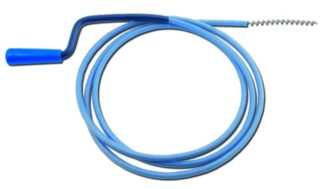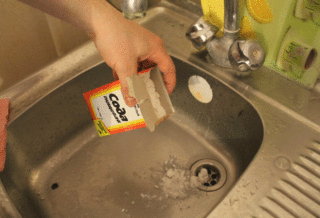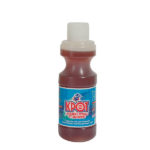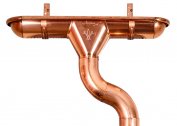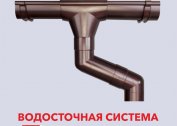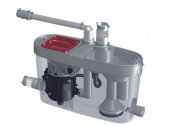Siltation of the sewer collector leads to a narrowing of the inner lumen of the pipes. As a result, drains move to the final receiver more slowly, forming traffic jams, stagnation. To overcome sludge from fat and pieces of food debris on the inner walls of the communication, you can use the “Mole” to clean the sewer pipe. But besides this method, there are other methods of dealing with the problem.
The importance of cleaning the sewer from the accumulated fat in it
 Dense food effluents enter the sewer more often through a kitchen pipe. Fat from a dirty frying pan, broths, leftovers of soups and other similar wastes go into the sink. It is especially bad if such drains merge into the pipeline while still hot. Faced with the cool temperature of plastic or cast iron and cold water, the fat thickens, slows down and settles on the pipe walls.
Dense food effluents enter the sewer more often through a kitchen pipe. Fat from a dirty frying pan, broths, leftovers of soups and other similar wastes go into the sink. It is especially bad if such drains merge into the pipeline while still hot. Faced with the cool temperature of plastic or cast iron and cold water, the fat thickens, slows down and settles on the pipe walls.
Pieces of food falling into the sewer aggravate the situation. They are attached to a sticky fatty film and thus a growth is obtained. It is like a coral, which is growing more and more.
As a result of such formations, the following problems arise:
- partial or complete blockage of the pipe;
- slowing down the outflow of dirty water;
- reproduction of bacteria in the collector;
- pungent, offensive smell from the sink or bath.
The most common locations for fat plugs are the kitchen section of the pipe and the walls of the sewer pit, which receives drains with leftovers / soup left in the toilet. It also accumulates potogira particles washed off from the body of the shower.
Methods for cleaning sewer pipes
There are several popular ways to deal with fatty sludge in pipes. And you can use them without the help of professionals. The easiest of them is cable cleaning.
Cable
This method is the most radical, but it removes all growths on the walls of the pipes to the septic tank / pit. If chemicals or a plunger work locally on the first 15-25 cm of the collector from draining the sink / bath / toilet, then the cable can be extended to the receiver.
Act in this way:
- Take a long plumbing cable. Its length should be enough for 10-15 meters of the collector.
- A special rounded ruff is put on the cable.
- The work is carried out together. The first master constantly rotates the cable, and the second continuously propels it forward. It is necessary to clean the collector with this method until it reaches the pit.
- If the steel fixture rests against the cork, rotational movements back and forth must be made. This will allow you to break through the cork and move forward.
- At the end of the work, the entire collector is washed with a large amount of hot water to remove residual fat from its walls.
This method helps not only to pierce the fat in the sewer pipe, but also to remove the formed sludge on the walls. But here you need to be careful: it is strictly forbidden to use a split steel cable or a pointed metal ruff. They scratch the inner smooth surface of the plastic pipes.
Hot water and soda
If there is suspicion of the formation of sludge in the pipeline (water leaves more slowly), you can try to flush the sewer pipes from grease with hot water. To do this, pour half a glass of baking soda into the tub and sink drain. It is important to try to pour it into dry plumbing fixtures. So the soda will drop to overflow. Then, 1 liter of very hot water (70-80 degrees) is poured here and the plums are closed. Inside the reservoir, a reaction will begin that will split the fat.
After about 10-15 minutes, turn on the hot water (60-70 degrees) and thoroughly flush the pipeline for 20 minutes. High temperatures help dissolve the grease film and transport it to the drain pit.
Chemicals
There are chemicals for cleaning grease from sewer pipes in a house or apartment. Most often in Russia they use the cleaning agent “Mole”. You can also use the usual "Domestos" or "Tiret Turbo." The components of the “Mole” are potassium and sodium hydroxide. Tiret and Domestos contain surfactants and 10% chlorine bleach.
They act in the following order:
- The selected product in the amount of 0.5 cups (or 1 sachet if it is “Mole”) is poured / put into the sink / bathtub drain.
- About 1 liter of very hot water is sent here. Within an hour, the chemical will work against fat.
- Then it remains only to flush the pipes with a large amount of hot clean liquid.
Against deep and thick deposits, this method does not work.
Sewer Pit Cleaning
If in a private house there is a receiver without a bottom - just a hole in the ground - you need to deal with fat carefully. Various chemicals such as caustic soda and the like can seriously damage the soil and groundwater. They will overcome fat, but then seep further into the soil. In leaky receivers, it is better to use bacterial preparations. They perfectly decompose feces, fat, food waste. However, biological preparations do not work in an aggressive environment, and powder water, detergents and cleaning products are equally poured into the sewers of a private house.
There is only one way out - the use of an ilosos, or digging a hole and forming a new one, this time airtight.
To break down fat in a sealed sewer pit, caustic can be used, but very carefully. He mercilessly burns any living tissue, so you need to work in protective gloves and a mask. According to the instructions, caustic is diluted with 8-10 liters of water before use. The mixture is well stirred until the soda granules dissolve. For 1 m3 pits take 0.5-0.7 kg of funds. The liquid is poured into the receiver and wait 4-5 minutes. Then the drains can be pumped out with a cesspool.
Prevention of fat accumulation in sewers
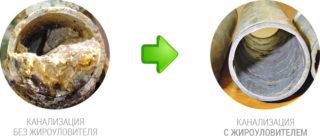 In order not to resort to the use of aggressive chemicals and not to use heavy artillery in the form of a plumbing cable, it is better to install a grease trap for preventive purposes. This device allows you to effectively remove fat from water before it enters the pit. As a result, the sewer system will be insured against the formation of dense growths.
In order not to resort to the use of aggressive chemicals and not to use heavy artillery in the form of a plumbing cable, it is better to install a grease trap for preventive purposes. This device allows you to effectively remove fat from water before it enters the pit. As a result, the sewer system will be insured against the formation of dense growths.
The grease trap operates in two stages:
- in the first section cleans drains from food and other debris;
- in the second compartment removes fat from water.
If you don’t want to install the device, it is advisable to thoroughly rinse the sewer pipes with hot water once every 2-3 months. The temperature of the liquid is approximately 60-70 degrees. Flushing time - at least 15-20 minutes. You can simultaneously help plunger. If the device is used in a bath, you need to close the overflow, otherwise the efficiency from using the plunger will be low due to pressure drops in the system.
Try to avoid getting personal hygiene items, rags, paper, food waste into the collector.
